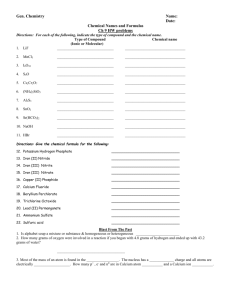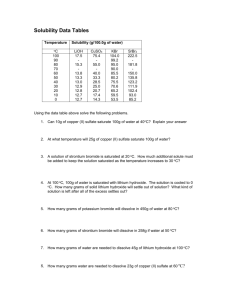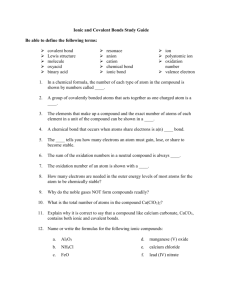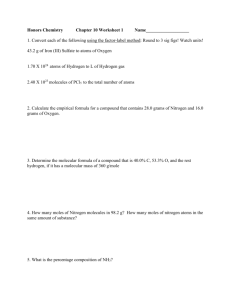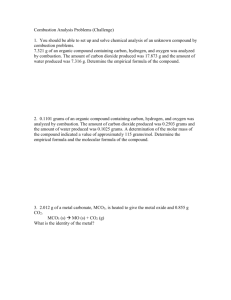Chemistry 834 - Sacred Heart Academy
advertisement
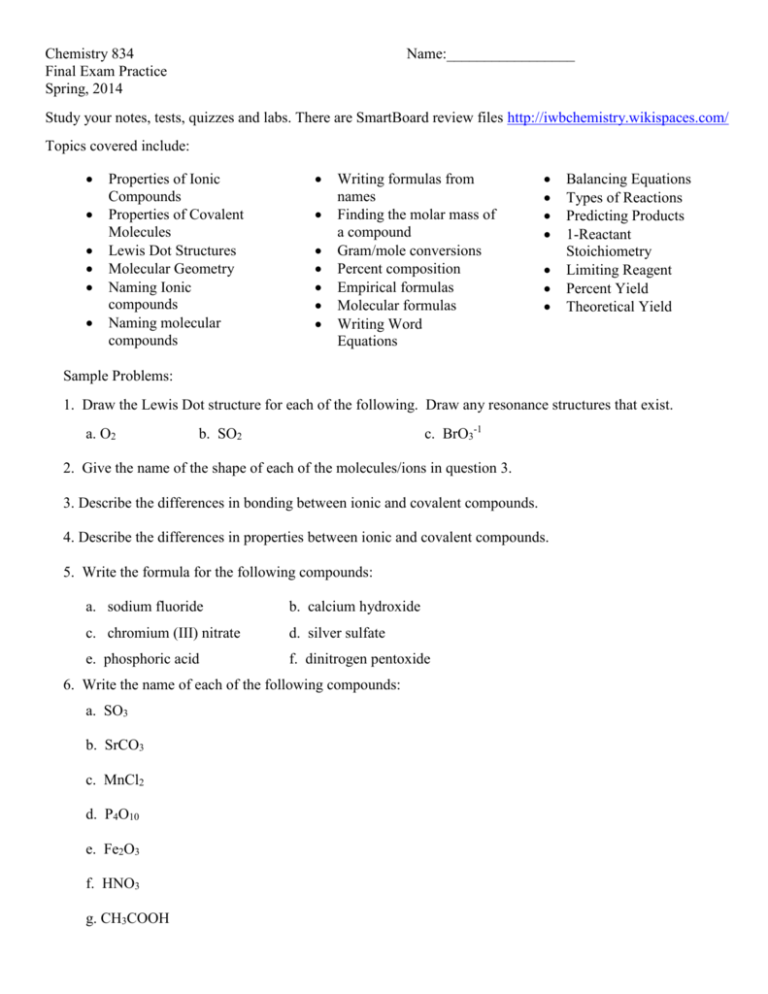
Chemistry 834 Final Exam Practice Spring, 2014 Name:_________________ Study your notes, tests, quizzes and labs. There are SmartBoard review files http://iwbchemistry.wikispaces.com/ Topics covered include: Properties of Ionic Compounds Properties of Covalent Molecules Lewis Dot Structures Molecular Geometry Naming Ionic compounds Naming molecular compounds Writing formulas from names Finding the molar mass of a compound Gram/mole conversions Percent composition Empirical formulas Molecular formulas Writing Word Equations Balancing Equations Types of Reactions Predicting Products 1-Reactant Stoichiometry Limiting Reagent Percent Yield Theoretical Yield Sample Problems: 1. Draw the Lewis Dot structure for each of the following. Draw any resonance structures that exist. a. O2 c. BrO3-1 b. SO2 2. Give the name of the shape of each of the molecules/ions in question 3. 3. Describe the differences in bonding between ionic and covalent compounds. 4. Describe the differences in properties between ionic and covalent compounds. 5. Write the formula for the following compounds: a. sodium fluoride b. calcium hydroxide c. chromium (III) nitrate d. silver sulfate e. phosphoric acid f. dinitrogen pentoxide 6. Write the name of each of the following compounds: a. SO3 b. SrCO3 c. MnCl2 d. P4O10 e. Fe2O3 f. HNO3 g. CH3COOH 7. What ions make up the following compounds? a. FeCl3 b. Ni(OH)2 c. Al2(CO3)3 d. CaSO4 e. SO3 8. a. If you have 45.6 grams of Mg(NO3)2, how many moles of Mg(NO3)2 do you have? b. If you have 45.6 grams of Mg(NO3)2, how many grams of nitrogen do you have? 9. What is the percent composition of C6H4Br2? 10. A compound is 54.53% carbon, 9.15% hydrogen and the rest oxygen. The molar mass of the compound is 88. What is the empirical formula of the compound? What is the molecular formula for the compound? 11. Write the balanced chemical equation for each of the following word equations (include states of matter): a. calcium hydroxide plus iron (III) nitrate yields calcium nitrate plus iron (III) hydroxide b. magnesium plus hydrochloric acid yields magnesium chloride plus hydrogen gas. c. hydrogen peroxide decomposes with a yeast catalyst to form water and oxygen gas. 12. Balance the following equations: a. Li + O2 Li2O b. Na + H2O NaOH + H2 c. Cl2 + FeI3 FeCl3 + I2 d. MgSO4 + NaBr MgBr2 + Na2SO4 e. C9H20 + O2 CO2 + H2O 13. Write the type of reaction for each reaction in question 14 above. 14. Given the equation N2(g) + 3H2(g) 2NH3(g) a. If 3.21 moles of N2 is reacted with excess hydrogen gas, how many moles of NH3(g) will be formed? b. How many grams of hydrogen gas will be used up in the reaction in part a? 15. Predict the products of the following equations and write the balanced chemical equation. Determine the type of reaction. a. sodium phosphate plus calcium nitrate b. pentane (C5H12) burning in oxygen c. zinc metal plus sulfuric acid d. bromine plus iron (III) chloride e. hydrogen plus chlorine 16. Predict whether or not each of the following reactions will happen. If so, write a balanced chemical equation for the reaction. If not, write the formula of the reactants and write, “no reaction”. a. A piece of magnesium is added to a beaker of cold water. b. A small amount of cobalt is added to a solution of hydrochloric acid c. A piece of aluminum is mixed with an aqueous solution of potassium nitrate. d. A piece of nickel is added to a beaker containing an aqueous solution of lead(II) nitrate. 17. Consider the double replacement reaction of aluminum hydroxide and calcium sulfate. a. Write a balanced chemical equation for the process. b. If you have 50 grams of each reactant, which is the limiting reagent? c. How many grams of aluminum hydroxide are used up in the reaction? d. How many grams of calcium sulfate are used up in the reaction? e. How many grams of aluminum hydroxide are left at the end of the reaction? f. How many grams of calcium sulfate are left at the end of the reactions? g. How many grams of each product are formed in the reaction, assuming an 80% yield of each product?


